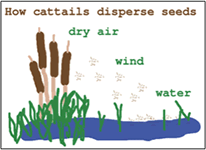 Infer
Infer
Inventing a new way to build a backyard fort, creating an innovative approach to recycling, and building a case against a new coal power plant all involve applying evidence to solve problems and make decisions.
Evidence is necessary to support a claim, justify change, or make an informed decision.
"If you can recycle plastic, why not reuse shoes?"
Seeking Patterns of Evidence
Students must learn to identify, process, and judge evidence. This begins with looking for patterns of evidence. Ask:
- What evidence is most useful in addressing my questions?
- How does this evidence connect with what I already know?
- How is this evidence relevant for my question?
- What are my assumptions?
- What am I guessing about and what do I know for sure?
- What evidence is from primary versus secondary sources?
- Which sources are bias and which are credible?
- What are all the possible perspectives and viewpoints?
- Why would someone consider one viewpoint better/worse?
- What pieces of evidence support and refute a perspective?
- What are the most important pieces of evidence?
- What are the supporting pieces of evidence?
- What are the patterns of evidence?
- What new questions does this evidence raise?
Look for patterns of evidence in visual materials. Examine photos, make inferences, and show conclusions.
 Rethink an assignment.
Rethink an assignment.
Focus on the collecting evidence and building convincing arguments.
Developing Convincing Arguments
Arguments provide evidence to support a claim. To develop useful arguments, inquirers must evaluate evidence, examine different points of view, and determine the most logical approach or meaningful conclusion. Ask:
- How does the evidence fit together?
- What claims and supporting arguments could be made?
- How can the evidence be arranged to support a conclusion?
- What’s the core of the argument?
- What pieces of evidence support what perspectives?
- How do the arguments fit with my understandings?
- What is the reasoning behind each argument?
- What are the limitations of these arguments?
- What are the errors in reasoning?
- Where are the holes in the evidence?
- How could this information be misleading?
- What are the problems and barriers?
- How could it be corrected or improved?
- What are the relationships/causes/effect?
 Observations and visual notes can be helpful to making decisions.
Observations and visual notes can be helpful to making decisions.
An easy approach for younger students involves three statements:
- I see...
- I think..
- I conclude...
"I’m a Junior CSI trying to figure out what caused the death of Mr. Lymen."
Ask more experienced students to build on the visual documentation begun by others.
"One pond contains an invasive plant called lythrum salicaria. Last year the plant was removed from the second study location. We’re looking for convincing evidence showing whether removing the invasive species makes a difference in the habitat."
Involve more mature students in dealing with topics containing multiple perspectives and many possible solutions.
"While reading the historical fiction book, The Big Burn, by Jeanette Ingold I became interested in learning the facts behind the role of the Forest Service in managing fires, so I watched documentaries, read books, examined websites, and conducted online interviews to gather information and identify the different perspectives."
 Discuss the different perspectives on how wildfires should be managed. What types of evidence will you seek to support your point of view.
Discuss the different perspectives on how wildfires should be managed. What types of evidence will you seek to support your point of view.
Use the questions above as a guide.
Deductive arguments apply general principles and theories to specific situations. This is the most effective educational technique. Students are asked to explain their hypotheses, experiments and conclusions.
Provide opportunities for students to try out their ideas and apply what they've learned to real-world problems. For example, children might apply the four principles of flight to predict which paper airplane will work best. Rather than simply reading about machines and write a report, children design and test an invention. Go to the Forces of Flight website.
Another approach is to ask students to turn facts into a visually convincing argument that can be shared. For example, show me that this computer game is or isn't accurate. In a recent NPR program titled E.O. Wilson and Will Wright: An Lovers Unite! Wilson stated "I think games are the future in education. We're going through a rapid transition now. We're about to leave print and textbooks behind." Use the following gaming sites:
- Federation of America Scientists - Learning Technologies Projects
- Nobel Prize Educational Productions
- Routes: Discover the Secrets in Your Genes
 When designing persuasive messages, ask:
When designing persuasive messages, ask:
- Who is my audience and what do they need to know?
- What are examples and nonexamples?
- In what ways can the evidence be presented to communicate the argument?
- How can my messages be shared in an effective, efficient, and appealing way?
- How can my message be conveyed in a number of different ways?
- What parts of the argument are difficult to understanding?
For instance, children may become "machine detectives." After collecting information at EdHeads about simple machines, their job is to collect evidence of simple machines by identifying and photographing them around the school. Rather than a traditional powerpoint presentation, they created a comic using PowerPoint.
Facilitate Inquiry
Use guiding questions to facilitate inquiry:
- Is there a single solution or alternate solutions?
- Does the solution make sense? Is it reasonable? Why or why not?
- What evidence supports my conclusion?
- How does this result compare to my original guess?
- How will I explain this conclusions to others or take action?
- Is my conclusion correct or valid?
- How can the result be visualized?
- How can the result be shared?
- What can I or others use this information? How can this be applied to other problems?
- What are the sources of errors or problems in the solution?
- How is my answer like and unlike others?
- Do you want to share with people in your class or the world?
- Do you want to share temporarily or permanently?
- Could you write a letter or email?
- Could you make a sign for the kitchen, hallway, or area business?
- Could you make a group decision and create a "Science Squad" shared announcement?
Inferring and Technology
 Use public domain resources such as the NOAA Photo Library for images. Rather than using standard images, be creative:
Use public domain resources such as the NOAA Photo Library for images. Rather than using standard images, be creative:
- Use a single image cropped different ways and placed in PowerPoint.
- Take many photos of the same subject from different perspectives.
- Create different ways to represent the same subject.
Use technology to create and share solutions.
- Production Tools
- Google Docs with an embedded draw
- Animation
- Audio
- Blog
- Comic Software
- Comic Life. Available for both Mac and Windows *
- Comic Creator
for Kids
- Build Your Own Comic
- Disney's Comic Creator
- Kabam! Comic Creator
- Kiddonet
- Make BeliefsComix
- Make Your Own Graphix
- Pixton
- ReadWriteThink Cartoon Creator. Make a comic strip using a set of visuals
- Scholastic's Captain Underpant
- Strip Creator (no sign-in, easy, basic)
- Comic Creators for All Ages (potential for inappropriate content)
- Cartoon and Caption Creators
- PicBite - choose a picture and add a caption
- Picture Poetry - choose picture and write a caption
- Cover Generator - Cover Creator
- Cubes - Bio-Cube, Mystery Cube
- Draw Tools
- CoSketch (free, no password, draw, draw on Google maps, collaborative, embed live)
- Dabbleboard (free, sign-up or not, draw, insert images, collaborative, share the URL, chat, embed live)
- FlockDraw (free, no sign-up)
- Kerpoof
- Skrbl - collaborative drawing tool
- Codes and Language
- Morse Code - Morse Code
- Essay Map - Essay Map
- Flipbook Generator - Flip Book
- Floor Plans
- Create your own museum
- Floorplan (signup, one floorplan
- Image Manipulation
- Bomomo - create works of art
- Glass Giant - put one image in another
- Historical Scene Investigation
- ImageChef - add yourself to photos. Great as writing prompt
- Flauntr.com - very easy to use photo editor
- PicResize - helps resize photos
- Letter Generator - Letter Generator
- Map Makers - Map Maker - Select a map and fill it with data.
- Multimedia
- 280 Slides - photos, movies, PowerPoint
- Big Huge Labs - slide show with web images and Flickr images
- Google Presentations
- MagToo - lots of extras for creating panorama shows, maps, and more
- Mixbook - photobook; collaborative feature
- SlideShare * - slide sharing
- VoiceThread
- Persuasive Essay - Persuasion Map
- Poem Generator - Acrostic Poems, Shape Poem
- Postcard Generator - Postcard Creator
- Poster Maker - Glogster (tessellation example), Letterpop
- Screen Casts - Sketchcast (sign-up, record your drawing, include your voice, share, embed)
- Sign Generators - Warning Label Generator
- Spreadsheets
- EditGrid (free, sign-up required, collaborate)
- Google Spreadsheets
- Trading Card Generator - Trading Cards
- Video Generator
- Shark Video Mixer from Discovery - create a shark video
- Wikis
Assimilating and Inferring - A Recursive Cycle
 In most academic situations, inquiry involves accumulating evidence that supports inferences that seem reasonable, logical, and persuasive. Students ask:
In most academic situations, inquiry involves accumulating evidence that supports inferences that seem reasonable, logical, and persuasive. Students ask:
- What inferences can I make based on the evidence?
- What conclusions can I draw?
- What decisions can I make?
 Try It
Try It
The cycle of assimilating and inferring is often skipped over.
What can be done to ensure that this stage gets the time it deserves?
With each inquiry cycle, inquirers must revisit questions with an open mind.
- What evidence do I still need to gather?
- What has changed since my last cycle of questioning, exploring, assimilating,
and inferring?
- Have I visualized the evidence in many different ways?
- What pieces of information still need to be connected? What’s not obvious?
- Are there alternatives I haven’t considered? Are there opinions I should seek?
- What are the risks and benefits of each approach?
- What generalizations can I draw based on the evidence?
- Do I have enough information to draw a conclusion or make a decision?
- How do I most effectively present arguments and cite evidence?
- How can graphics be used to better understand the data and my conclusions?
 Try It
Try It
Try a creation tool such as a comic generator like Make BeliefsComix.
Create a sample product for your classroom that you could use as an example.
For a more in-depth exploration, read the graphic book Graphic Inquiry by Annette Lamb and Danny Callison available from Libraries Unlimited, 2011.




